Zen and Vega DDR4 Memory Scaling on AMD's APUs
by Gavin Bonshor on June 28, 2018 9:00 AM EST- Posted in
- CPUs
- Memory
- G.Skill
- AMD
- DDR4
- DRAM
- APU
- Ryzen
- Raven Ridge
- Scaling
- Ryzen 3 2200G
- Ryzen 5 2400G
Integrated Gaming Performance
As stated on the first page, here we take both APUs from DDR4-2133 to DDR4-3466 and run our testing suite at each stage. For our gaming tests, we are only concerned with real-world resolutions and settings for these games. It would be fairly easy to adjust the settings in each game to a CPU limited scenario, however the results from such a test are mostly pointless and non-transferable to the real world in our view. Scaling takes many forms, based on GPU, resolution, detail levels, and settings, so we want to make sure the results correlate to what users will see day-to-day.
Civilization 6
First up in our APU gaming tests is Civilization 6. Originally penned by Sid Meier and his team, the Civ series of turn-based strategy games are a cult classic, and many an excuse for an all-nighter trying to get Gandhi to declare war on you due to an integer underflow. Truth be told I never actually played the first version, but every edition from the second to the sixth, including the fourth as voiced by the late Leonard Nimoy, it a game that is easy to pick up, but hard to master.
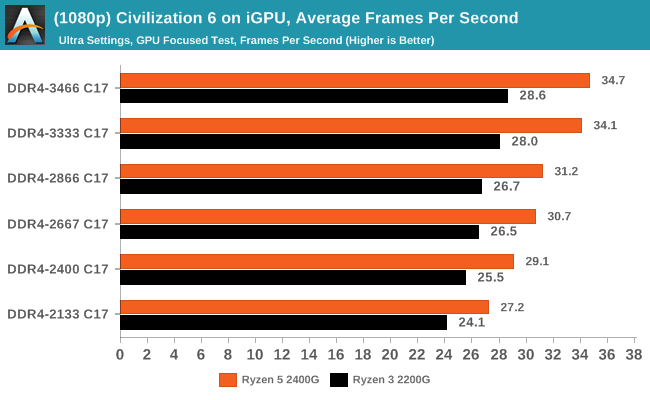

Civilazation 6 certainly appreciates faster memory on integrated graphics, showing a +28% gain for the 2400G on average framerates, or a +13% gain when compared to the APU rated memory frequency (DDR4-2666).
Ashes of the Singularity (DX12)
Seen as the holy child of DX12, Ashes of the Singularity (AoTS, or just Ashes) has been the first title to actively go and explore as many of the DX12 features as it possibly can. Stardock, the developer behind the Nitrous engine which powers the game, has ensured that the real-time strategy title takes advantage of multiple cores and multiple graphics cards, in as many configurations as possible.
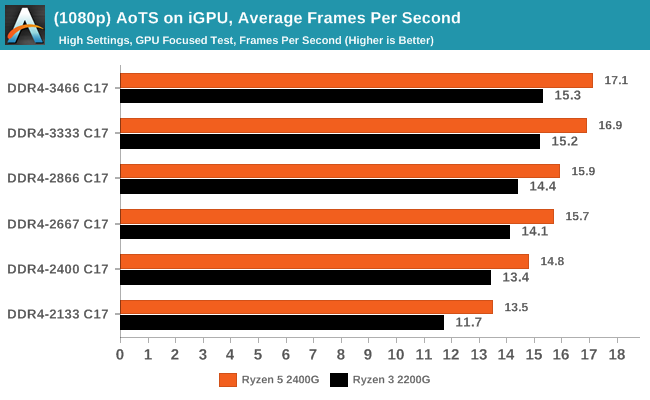
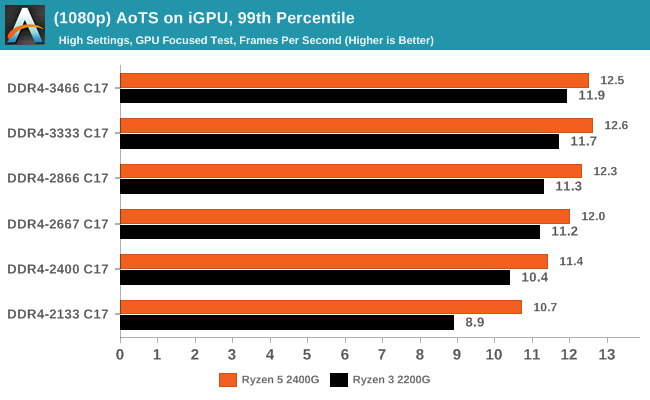
In Ashes, both CPUs saw a 26-30% gain in frame rates moving from the slow to fast memory, which is also seen in the percentile numbers.
Rise Of The Tomb Raider (DX12)
One of the newest games in the gaming benchmark suite is Rise of the Tomb Raider (RoTR), developed by Crystal Dynamics, and the sequel to the popular Tomb Raider which was loved for its automated benchmark mode. But don’t let that fool you: the benchmark mode in RoTR is very much different this time around. Visually, the previous Tomb Raider pushed realism to the limits with features such as TressFX, and the new RoTR goes one stage further when it comes to graphics fidelity. This leads to an interesting set of requirements in hardware: some sections of the game are typically GPU limited, whereas others with a lot of long-range physics can be CPU limited, depending on how the driver can translate the DirectX 12 workload.
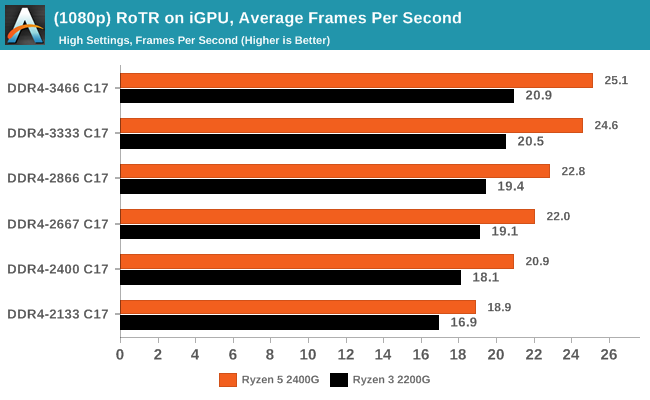
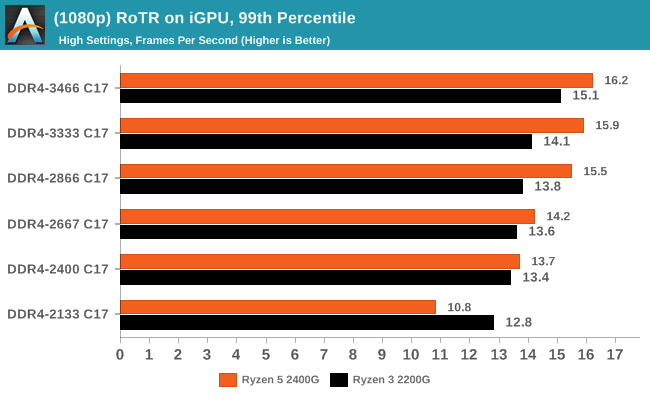
Both CPUs saw big gains in RoTR, however it is interesting to note that the 2400G gained margin over the 2200G: at DDR4-2133, the difference between the two APUs was 12%, however with the fast memory that difference grew to +20%.
Shadow of Mordor
The next title in our testing is a battle of system performance with the open world action-adventure title, Middle Earth: Shadow of Mordor (SoM for short). Produced by Monolith and using the LithTech Jupiter EX engine and numerous detail add-ons, SoM goes for detail and complexity. The main story itself was written by the same writer as Red Dead Redemption, and it received Zero Punctuation’s Game of The Year in 2014.
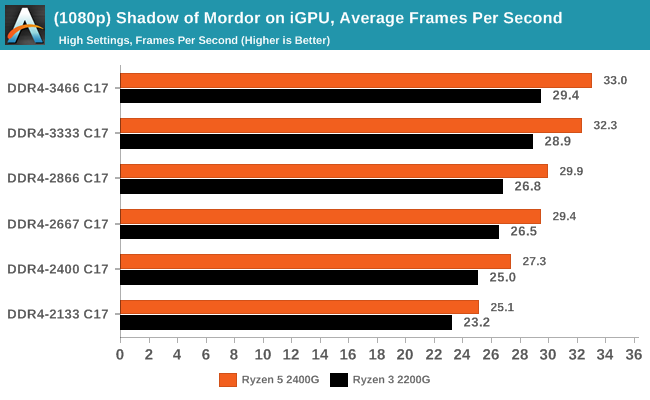
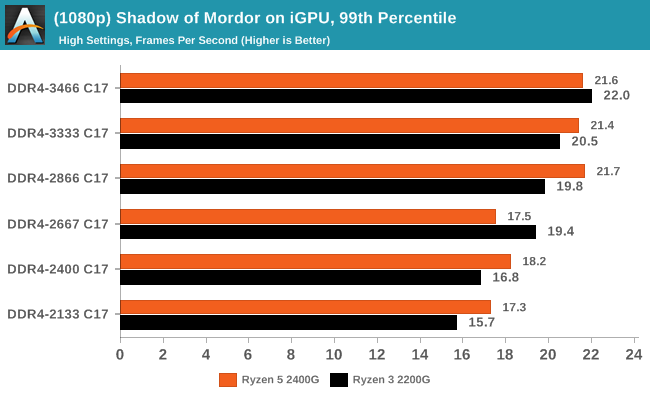
Shadow of Mordor also saw results rise from 26-32% for average frame rates, while the percentiles are a different story. The Ryzen 5 2400G seemed to top our at DDR4-2866, while the Ryzen 3 2200G was able to keep going and then beat the other APU. This is despite the fact that the 2200G has less graphical horsepower than the 2400G.
F1 2017
Released in the same year as the title suggests, F1 2017 is the ninth variant of the franchise to be published and developed by Codemasters. The game is based around the F1 2017 season and has been and licensed by the sports official governing body, the Federation Internationale de l’Automobile (FIA). F1 2017 features all twenty racing circuits, all twenty drivers across ten teams and allows F1 fans to immerse themselves into the world of Formula One with a rather comprehensive world championship season mode.

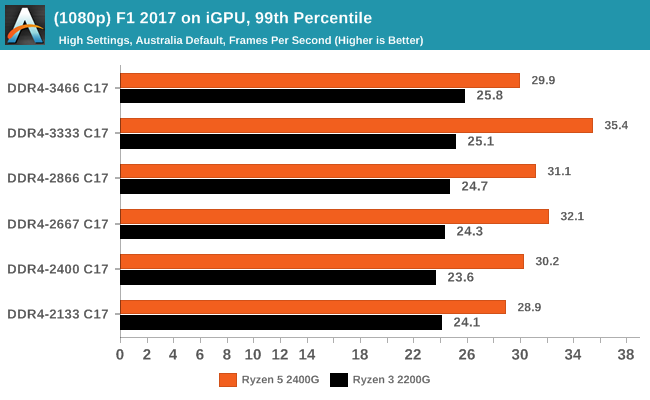
Codemasters game engines are usually very positive when memory frequency comes into play, and although positive generally in F1 2017, it didn't seem to affect performance as much as expected. While average frame rates showed a gradual rise in performance through the straps, the Ryzen 5 2400G 99th percentile results were all over the place and not consistent at all.
Total War: WARHAMMER 2
Not only is the Total War franchise one of the most popular real-time tactical strategy titles of all time, but Sega delve into multiple worlds such as the Roman Empire, Napoleonic era and even Attila the Hun, but more recently they nosedived into the world of Games Workshop via the WARHAMMER series. Developers Creative Assembly have used their latest RTS battle title with the much talked about DirectX 12 API, just like the original version, Total War: WARHAMMER, so that this title can benefit from all the associated features that comes with it. The game itself is very CPU intensive and is capable of pushing any top end system to their limits.
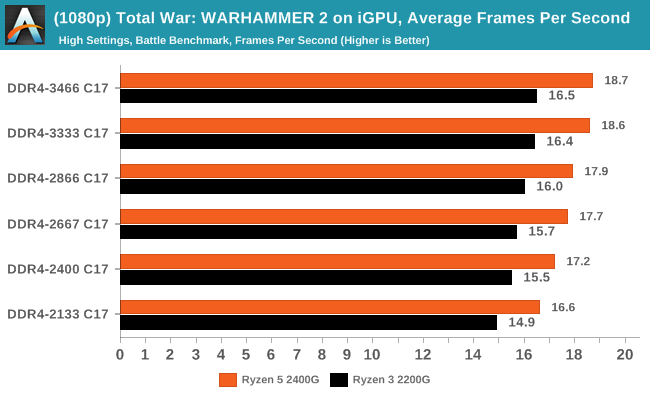
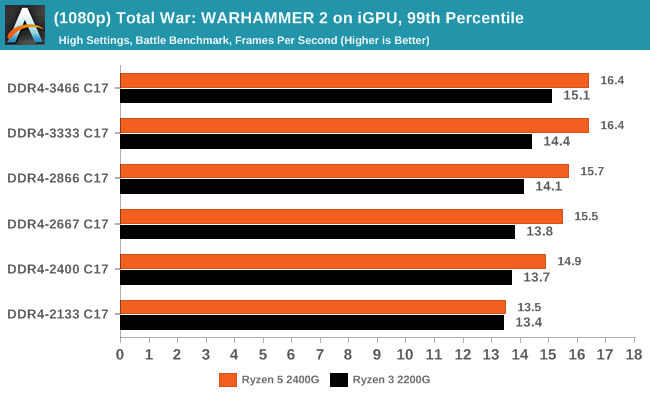






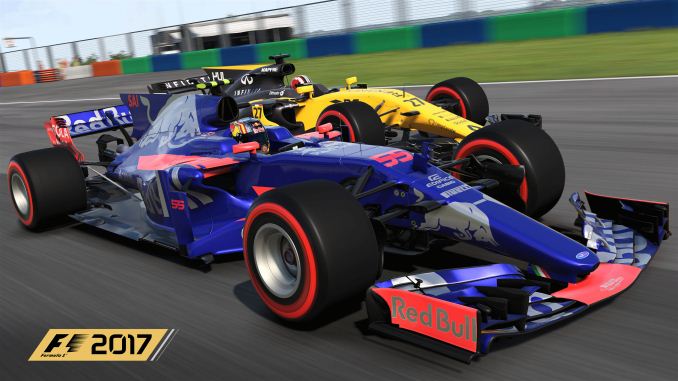
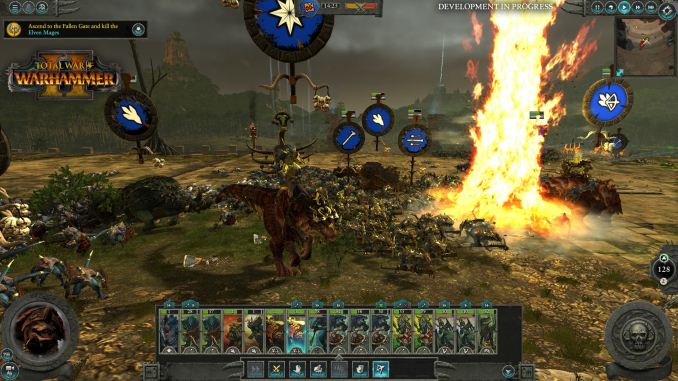








74 Comments
View All Comments
invasmani - Tuesday, July 10, 2018 - link
We really need quad channel memory to become mainstream on low end CPU's ideally and octa channel or even six channel or example to become more affordable on mid range ones. The ram itself performance increases are slowly so we need to run more parallel memory channels similar to CPU cores like Ryzen has done well with.peevee - Thursday, June 28, 2018 - link
"With the aim being to procure a set of consistent results, the G.Skill Ripjaws V DDR4-3600 kit was set to latencies of 17-18-18-38 throughout"By doing that, you essentially invalidated the test as in real life lower frequencies mean lower values for those latency-inducing parameters, reducing the impact of frequencies.
edzieba - Thursday, June 28, 2018 - link
Setting a constant CAS actually increases the impact on latency compared to most RAM available. CAS is a clock-relative measure, and normally you will see CAS latencies rise as clockspeeds rise. This means real-time latencies (nanoseconds) stay surprisingly flat across clock frequencies. Only if you pay the excruciating prices for low-CAS high-clock DIMMs (in which case, why on earth are you using them with a budget APU?) do you start to see appreciable reductions in access latency.Of course, higher clock rates means more access /granularity/ even if latency is static so it depends on what your workload benefits from.
peevee - Thursday, June 28, 2018 - link
That was exactly my point. You you can run CAS 17 at 3466, you can CAS 12 or 13 at 2133, even on much less expensive memory. And then difference in the results will be much less.As surprising as it might seem, the memory latencies for a while hit the limitations of speed of electromagnetic wave in the wires, and the only solution (both for latencies and energy consumption) with those outdated Von Neumann-based CPU architectures is to do PIP, like in the phones, instead of DIMMs/SODIMMs.
mode_13h - Thursday, June 28, 2018 - link
I've been hoping to see HBM2 appear in phones and (at least laptop) CPUs for a while, now.peevee - Tuesday, July 3, 2018 - link
HBM2 has nothing to do with it.Phones actually get it right, they usually have memory in stacked configuration with CPU reducing the length of the wires to the minimum. Or at least set the memory chips close to the CPU. Desktop CPUs using DIMMs are hopeless. They could have improved things with a special CPU slot which would accept DIMMs (or better yet SODIMMs) in square configuration, like this:
*DIMM*
D|--C--|D
I-||--P--|I
M|--U--|M
M|------|M
*DIMM*
peevee - Tuesday, July 3, 2018 - link
The best for the DIMMs would be to lie flat, and CPU has 4 memory channels with pins on each side for each channel. Best of all would be LPDDR4x, with 0.6V signal voltage, would save a bunch for the whole platform. Something like 4-channel CL4 1866 or 2133 would have plenty of bandwidth and properly low latency, maybe even LLC will not be needed for 4 cores or less.peevee - Tuesday, July 3, 2018 - link
..."would save a bunch" of power...Lolimaster - Friday, June 29, 2018 - link
The thing is DDR4 3000 CL15 barely cost a few buck over 2400 CL15.Lolimaster - Friday, June 29, 2018 - link
All memory even cheapo 2133 are in the range of 165-180. Only CL14 3200 is above $200.